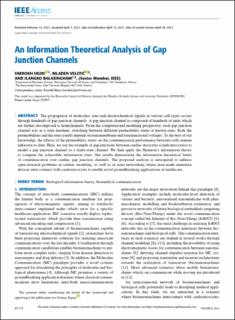| dc.contributor.author | Hejri, Farrokh | |
| dc.contributor.author | Veletic, Mladen | |
| dc.contributor.author | Balasingham, Ilangko | |
| dc.date.accessioned | 2023-01-26T10:03:19Z | |
| dc.date.available | 2023-01-26T10:03:19Z | |
| dc.date.created | 2021-07-08T22:34:08Z | |
| dc.date.issued | 2021 | |
| dc.identifier.citation | IEEE Access. 2021, 9 1-9. | en_US |
| dc.identifier.issn | 2169-3536 | |
| dc.identifier.uri | https://hdl.handle.net/11250/3046525 | |
| dc.description.abstract | The propagation of molecules, ions and electrochemical signals in various cell types occurs through hundreds of gap junction channels. A gap junction channel is composed of hundreds of units which are further decomposed to hemichannels. From the computational modeling perspective, each gap junction channel acts as a state machine, switching between different permeability states at known rates. Both the permeabilities and the rates jointly depend on transmembrane and transjunctional voltages. To the best of our knowledge, the effects of the permeability states on the communication performance between cells remain unknown to-date. Here, we use the example of gap junctions between cardiac myocytes (cardiomyocytes) to model a gap junction channel as a finite-state channel. We then apply the Shannon's information theory to compute the achievable information rates. Our results demonstrate the information theoretical limits of communication over cardiac gap junction channels. The proposed analysis is anticipated to address open-research problems in cardiac modeling, as well as in nano-networking where man-made miniature devices inter-connect with cardiomyocytes to enable novel groundbreaking applications in healthcare. | en_US |
| dc.language.iso | eng | en_US |
| dc.publisher | IEEE | en_US |
| dc.rights | Navngivelse 4.0 Internasjonal | * |
| dc.rights.uri | http://creativecommons.org/licenses/by/4.0/deed.no | * |
| dc.title | An Information Theoretical Analysis of Gap Junction Channels | en_US |
| dc.title.alternative | An Information Theoretical Analysis of Gap Junction Channels | en_US |
| dc.type | Peer reviewed | en_US |
| dc.type | Journal article | en_US |
| dc.description.version | publishedVersion | en_US |
| dc.source.pagenumber | 1-9 | en_US |
| dc.source.volume | 9 | en_US |
| dc.source.journal | IEEE Access | en_US |
| dc.identifier.doi | 10.1109/ACCESS.2021.3073247 | |
| dc.identifier.cristin | 1921077 | |
| cristin.ispublished | true | |
| cristin.fulltext | original | |
| cristin.qualitycode | 1 | |

